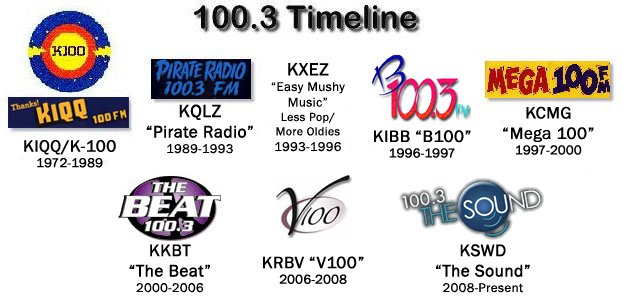WELCOME TO THE JUNGLE
Additional source material/correction: Adam Jacobson. Videos uploaded to YouTube by radiovoice70, saintdlee and nycradiofan

Image sent by Sal Garcia
| AM | XTRA | KEJK | KBIG | KGOE | KIEV | KGRB | KHJ | KGBS | KTNQ | XPRS | KRKD | KRLA | KEZY | KPPC | KFYF | KFOX | KUTY | KWIZ | KROQ | KZLA | KWOW |
| FM | KNX | KKHR | KMET | KGAB | KKBZ | KIQQ | KQLZ | KHJ FM | KMPC | KKDJ | KWST |
WELCOME TO THE JUNGLE
Additional source material/correction: Adam Jacobson. Videos uploaded to YouTube by radiovoice70, saintdlee and nycradiofan

Image sent by Sal Garcia
Los Angeles, California; St. Patrick's Day, 1989:
Thousands of K-LITE listeners switched on their radios this morning only to
find that their favorite music wasn't there. In its place were Joan Jett,
Guns 'N' Roses, Bon Jovi, Def Leppard, and a host of other hard rock and
alternative acts blasting out of their speakers. The renegade station, claiming
to be broadcasting from an abandoned warehouse off of Interstate 10, was
calling itself Pirate Radio.
Glam Rock was reaching its peak in popularity as the decade wound down. Westwood
One seized on the opportunity to capitalize on this, apparently, when they purchased
FM 100.3 in Los Angeles and changed the format to top-40 with a hard edge and a
diverse playlist, the likes of which the southland hadn't seen since Ten-Q.
(Find someone who likes all of the following artists: Madonna, Elvis
Costello, Tone-Loc, The Dead Milkmen, XTC, Skid Row, The Bangles, Milli Vanilli,
INXS, Metallica, and Depeche Mode, among many others.)
Anchored by morning man Scott Shannon (late of New York's Z-100), the station
was commercial-free for its first month on the air. Whitney Allen
anchored afternoons. Shannon also brought
with him a guy named Shadow Stevens, who called himself Shadoe Steele
on the air because he was not the same Mr. Stevens who did American Top 40,
Hollywood Squares and those wonderful Fred Rated commercials of the early 1980s. Pirate Radio gradually increased their emphasis of glam metal as time went on, featuring more and more acts like Warrant and Firehouse.
Their "illegal
station" gimmick eventually wore off, but they held on to the name even after
they went all-hard rock in the middle of 1991 and Shannon left.
On his last day, the announcer was rumored to have said, "Z-100 has left the building", a tip of the hat to Shannon's former employer, but that's not on the following aircheck.
Apparently bested in the ratings by Long Beach's heavy metal king KNAC, Pirate Radio went off in 1993 and switched to a modern rock format -- which lasted less than six months.
WHERE ARE THEY NOW?: After their failed attempt at modern rock, KQLZ
switched back to lite rock and adopted the calls KXEZ (which KYSR had
recently abandoned after becoming Star 98.7). In 1996, they changed calls
again, becoming KIBB (B-100.3), top-40 with a slight urban bent. On November 19, 1997, they became "Mega-100", an R&B station with an old-school flavor. They switched frequencies with 92.3 The Beat in 2000. They were KRBV "V-100", with an Urban AC/Urban Talk (Hybrid?) format from 2006-2008 (Source: Wikipedia), and had a loyal following as KSWD The Sound, from 2008 to 2017. Then they changed to the K-Love format, signing on as "KKLQ Los Angeles", which must be very confusing to someone from San Diego.
Scott Shannon was flown back to L.A. to do KROQ's Pirate Radio spoof on April Fools' Day 1994. He can be heard today on New York's WCBS FM 101.1 and also on the syndicated program Scott Shannon Presents America's Greatest Hits. Whitney Allen went over to KIIS-FM.
TRACKIN' THE CALLS: KQLZ is now assigned to FM 95.7 in New England, North Dakota, as Q95 Rock, under the same ownership as Country station KXDI.
SPECULATION: A 1997 issue of Rolling Stone noted that many
hard rock acts (read: hair bands) from the Pirate Radio era regrouped and/or made new albums, and
popped up on tours and college radio. Not enough to bring back the Pirate.

Image originally sent by Sal Garcia; modified by Jason Jones and Team FX MM
